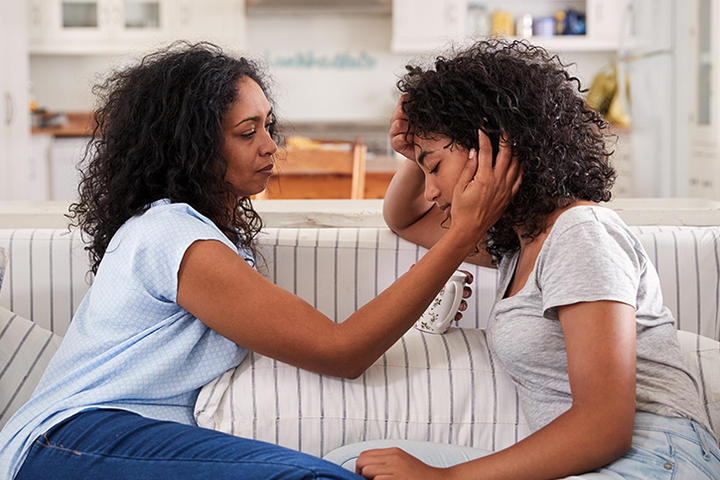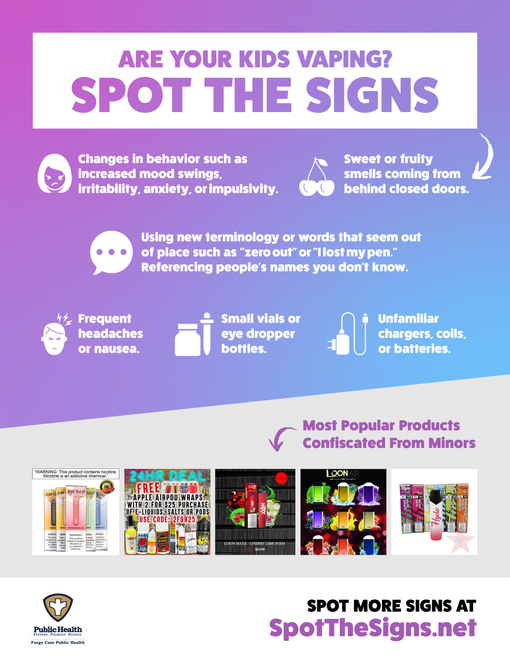
Spot the Signs of Vaping in Kids
There are many potential signs that your child or student could be vaping. If you spot any of the following signs, look for vape supplies.
- Declining academic or athletic performance.
- Sweet, minty, or fruity smells without an obvious source like candles, lotion, food, or gum.
- Changes in behavior such as increased mood swings, irritability, anxiety, or impulsivity.
- Using new terminology or words that seem out of place such as “zero out”, “I lost my pen”, “Can I borrow your book” or referring to people whose names you have never heard before.
- Frequent headaches, nausea, or dizziness.
- Increased risky behavior.
- Discarded pods or disposable devices.
- Unfamiliar USB, pens, highlighters, small vials, eye dropper bottles, coils, or batteries.
- Restlessness/sleeplessness.
- Complains of being out of breath.
Where should you look for vape supplies?
- Coats, hoodies, and pants pockets.
- Backpacks & purses.
- Between the mattress and box spring of your child’s bed.
- Unfamiliar chargers plugged into the back of gaming consoles.
- Apple-style watch worn with the clock upside down or showing the wrong time of day.
- In your teen’s car console or the floor of the vehicle.
- Behind closed doors if you smell sweet, fruity, or minty scents.
Where do kids vape?
- Bedrooms and bathrooms.
- While driving.
- On the bus, in classrooms and school bathrooms
What should I do if I find vape supplies?
The Office of the U.S. Surgeon General and American Lung Association have devoted a lot of resources to developing recommendations for parents on how to talk to kids about the dangers of vaping. Click the links for detailed recommendations or review the highlights below.
- Educate yourself about vaping. Good news - you’re already taking the first step by visiting the Fargo Cass Public Health website!
- Recognize vaping is an issue that will likely need to be discussed many times, over many days, weeks, or months. Experts say quick, frequent conversations are better than one long talk.
- Identify a low-pressure time and place to bring up vaping. Consider mentioning it casually while you’re together in the car or while preparing dinner. Remember to remain calm. FightFlavoredEcigs.org is a great resource that has sample conversations and responses to help parents.
- Ask your child why they are vaping. Listen carefully to the response. Is it boredom, anxiety, etc.? Help them find the words to describe why they vape so you can help them find a healthier alternative.
- This list of questions can help determine if they’re already addicted to the nicotine in vapes.
- Discuss the danger of becoming addicted to nicotine. (Information below.)
- Discuss the options they have for quitting. (Information below.)
Why is nicotine dangerous?
Nicotine is an addictive stimulant that acts on the same reward pathways as heroin or cocaine. It primes a child’s brain for future addictions.
Brain Development
The human brain continues to develop until age 25. Nicotine exposure prior to age 25 can change how a young person’s brain is formed, including the ability to pay attention, learn, and make decisions. Nicotine can affect their mood and can permanently lower impulse control.
Withdrawal
Nicotine withdrawal symptoms include anxious feelings such as a racing heart, distracted thinking, and sweaty palms. These symptoms may temporarily go away when a person vapes, but the cravings always come back, along with the anxious feelings. This can become a vicious cycle for kids dealing with anxiety and nicotine withdrawal. They think the vape calms them, but nicotine is actually a stimulant that creates more anxious feelings.
Resources to Quit Vaping
Fargo Cass Public Health is here to help. There are local, state and online resources available to help leave nicotine addiction behind:
Here are some resources to help you quit vaping and leave nicotine addiction behind.
• My Life My Quit – Text “Start My Quit” to 36072 My Life My Quit - North Dakota
• This is Quitting is a texting program designed to help those who want to quit vaping. Text VAPEFREEND to 88709.
• The Break Away from Nicotine (BAN) program at Fargo Cass Public Health offers free quitting resources to Cass County, ND residents. The program includes personalized, face-to-face counseling and for residents over the age of 18, a limited supply of nicotine replacement therapy. Call 701.241.8576 to learn more.

Additional Information for Parents and Teachers
- Spot the Signs Infographic - see image to the right
- E-Cigarettes: Information for Parents, Educators, and Health Care Providers (PDF)
- Request a Tobacco or Vape Presentation from Fargo Cass Public Health

